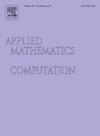A nonstandard numerical scheme for a novel SECIR integro-differential equation-based model allowing nonexponentially distributed stay times
IF 3.4
2区 数学
Q1 MATHEMATICS, APPLIED
引用次数: 0
Abstract
Ordinary differential equations (ODE) are a popular tool to model the spread of infectious diseases, yet they implicitly assume an exponential distribution to describe the flow from one infection state to another. However, scientific experience yields more plausible distributions where the likelihood of disease progression or recovery changes accordingly with the duration spent in a particular state of the disease. Furthermore, transmission dynamics depend heavily on the infectiousness of individuals. The corresponding nonlinear variation with the time individuals have already spent in an infectious state requires more realistic models. The previously mentioned items are particularly crucial when modeling dynamics at change points such as the implementation of nonpharmaceutical interventions. In order to capture these aspects and to enhance the accuracy of simulations, integro-differential equations (IDE) can be used.
In this paper, we propose a generalized model based on integro-differential equations with eight infection states. The model allows for variable stay time distributions and generalizes the concept of ODE-based models as well as IDE-based age-of-infection models. In this, we include particular infection states for severe and critical cases to allow for surveillance of the clinical sector, avoiding bottlenecks and overloads in critical epidemic situations.
On the other hand, a drawback of IDE-based models is that efficient numerical solvers are not as widely available as for ODE systems and tailored schemes might be needed. We will extend a recently introduced nonstandard numerical scheme to solve a simpler IDE-based model. This scheme is adapted to our more advanced model and we prove important mathematical and biological properties for the numerical solution. Furthermore, we validate our approach numerically by demonstrating the convergence rate. Eventually, we also show that our novel model is intrinsically capable of better assessing disease dynamics upon the introduction of nonpharmaceutical interventions.
允许非指数分布停留时间的新型SECIR积分-微分方程模型的非标准数值格式
常微分方程(ODE)是模拟传染病传播的一种流行工具,但它们隐含地假设了指数分布来描述从一种感染状态到另一种感染状态的流动。然而,科学经验得出了更合理的分布,即疾病进展或恢复的可能性随着疾病特定状态的持续时间而相应变化。此外,传播动态在很大程度上取决于个体的传染性。个体在感染状态下所花费时间的非线性变化需要更真实的模型。在对变化点(如非药物干预的实现)的动态建模时,前面提到的项目尤为重要。为了捕捉这些方面并提高模拟的准确性,可以使用积分微分方程(IDE)。本文提出了一个基于八种感染状态的积分-微分方程的广义模型。该模型允许可变停留时间分布,并推广了基于ode的模型和基于ide的感染年龄模型的概念。在这方面,我们包括严重和危急病例的特定感染状态,以便对临床部门进行监测,避免在危急的流行病情况下出现瓶颈和超载。另一方面,基于ide的模型的一个缺点是,高效的数值求解器不像用于ODE系统那样广泛可用,可能需要定制方案。我们将扩展最近引入的非标准数值格式来求解一个更简单的基于ide的模型。该方案适用于我们更先进的模型,并证明了数值解的重要数学和生物学性质。此外,我们通过证明收敛速度来验证我们的方法。最后,我们还表明,我们的新模型本质上能够更好地评估引入非药物干预后的疾病动态。
本文章由计算机程序翻译,如有差异,请以英文原文为准。
求助全文
约1分钟内获得全文
求助全文
来源期刊
CiteScore
7.90
自引率
10.00%
发文量
755
审稿时长
36 days
期刊介绍:
Applied Mathematics and Computation addresses work at the interface between applied mathematics, numerical computation, and applications of systems – oriented ideas to the physical, biological, social, and behavioral sciences, and emphasizes papers of a computational nature focusing on new algorithms, their analysis and numerical results.
In addition to presenting research papers, Applied Mathematics and Computation publishes review articles and single–topics issues.

 求助内容:
求助内容: 应助结果提醒方式:
应助结果提醒方式:


